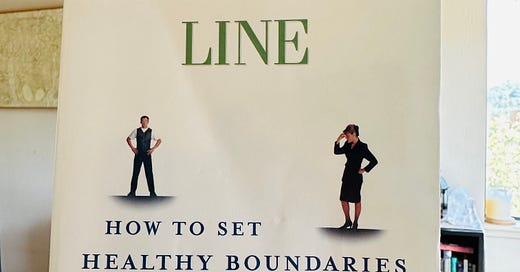The Boundaries That Protect Healthy Intimacy
Excerpts From Anne Katherine's Where To Draw The Line
I’m reading a great book about boundaries, Anne Katherine’s Where To Draw The Line, with my partner Jeff. The whole book is great, but I just wanted to share with you all some of the Cliff Notes of what I really appreciated, which is a check list of helpful “Do’s” and “Don’ts” from the chapter about boundaries that protect intimacy.
People with severe boundary wounding may read a list like this and think, “Yeah, nice. But nobody has ever treated me with that kind of respect. Why should I do that for someone else?” Because if you want a truly intimate relationship, it takes effort. And it takes care and empathy. It takes treating someone like they matter, like they deserve respect and being treated with dignity. If you breach these kinds of boundaries, intimacy erodes, and then all the good things about having a trusting relationship with someone you’re really close with start to fall apart.
We’re printing out this list to put on our refrigerator, and just in case it helps you all, we thought we’d share Anne Katherine’s very good advice.
Intimacy Skills
Notice when others extend themselves for you
Appreciate gifts of time, effort, money, energy, attention, and thoughtfulness
Take responsibility for communicating your needs
State your needs directly
Be honest about your feelings
Acknowledge your true, current position in the relationship, even though it may be hard for the other person to hear
Connect any shift towards separation with the events that caused it
Say what will restore you and make you available again for intimacy
Respect limits set by the other person
Respect reasonable requests
Confront the other person when something they do (or fail to do) is beginning to have negative impact on your relationship
When the other person’s action (or failure to act) feels disrespectful, thoughtless, or uncomfortable, say so
Boundaries That Promote Intimacy
Express issues in a timely fashion
Speak as honestly as possible
Express your feelings in a healthy way
Make time for communication
Appreciate the other person’s special efforts on your behalf
Soak up the other person’s expressions of love. For example, pause a moment when someone says “I love you.” Deliberately receive the meaning behind the words before responding.
Make regular times to enjoy leisure together
Share physical closeness that doesn’t always lead to sex
Chat about the thoughts and events of your day. Give the other person a picture of the part of your day you spent separately. Listen fully as your partner does the same for you.
Maintain sexual fidelity (Lissa’s caveat: assuming you’re monogamous or abiding by agreed upon terms if you’re practicing ethical non-monogamy)
When you realize you are heading towards an unexpected change, talk about it with your partner
Make important decisions together. Negotiate as necessary
Make amends when your partner has suffered negative consequences as a result of something you’ve done
When your partner does something that improves your life, respond with something that gives them joy
Violations of Intimacy Boundaries
Refusing to discuss important matters
Making a decision that affects the other person’s life without discussing it with them
Staying physically separate
Gratifying yourself sexually without consideration of the other’s sexual needs or limits
Sexual infidelity
Treating the other person coldly or angrily rather than handling conflict directly
Rage
Refusing to acknowledge how you may have hurt the other person
Not making amends for your mistakes
Boundaries are never as simple as a list of rules, but it can at least help spark conversations with the people you’re trying to be intimate with- or with your therapist. I hope this helps and recommend the rest of Anne Katherine’s books!
If you need help with your boundaries, I’m also releasing content from my unpublished book The Boundaries Handbook here for my paid subscribers and always appreciate those who can afford to help support all the free content I share!





